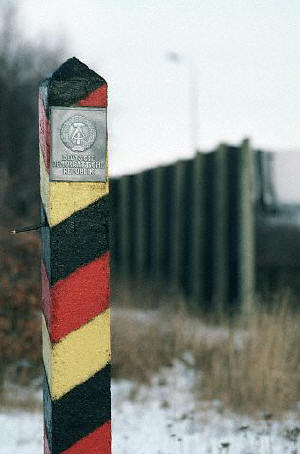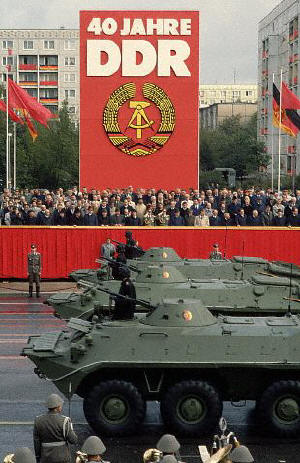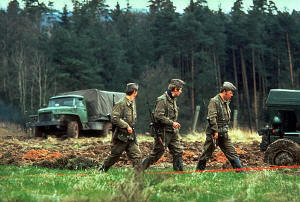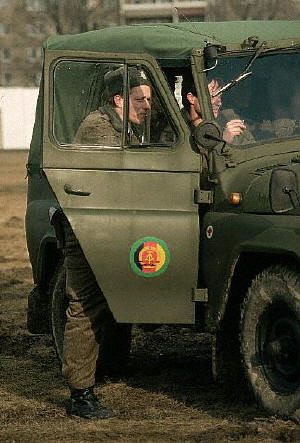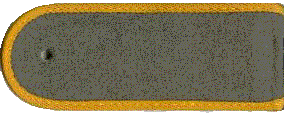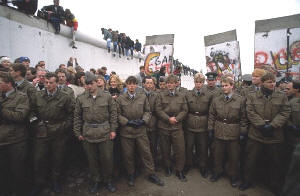Strichtarn.co.uk
Strichtarn - The rain or splinter camouflage pattern of the DDR (former East German) armed forces between 1965 and 1990
 nva-ddr.co.uk
nva-ddr.co.uk

East German Military Forces - Die Nationale Volksarmee der DDR
East German Gaz 66 R142 Radio Truck
Background
East German military forces comprised one of the Cold
War's most formidable armies. These same forces also kept the East German
population from revolting successfully against hard-line Communist rule for
over four decades. Furthermore, East Germany sent combat and security/intelligence
troops all over the world in conjunction with the Soviet Union's master plan
to spread Communism across the globe. They could function as an independent
military force if necessary, but were mainly factored into the Soviet Union's
defensive and offensive plans for all of Europe.
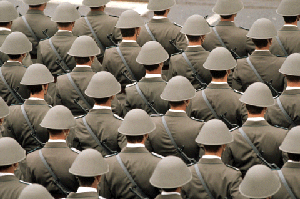
Soldaten der Nationalen Volksarmee (NVA) der DDR (©Corbis)
History
At the end of World War 2, the Western allies and the USSR divided much of
the world among themselves. Germany was no exception. The country was split
into four occupation zones, which later evolved into two separate and increasingly
antagonistic countries: West Germany, an ally of the West, and Communist East
Germany, the right hand of the Soviet Union. Both sides evaded cease-fire
agreements aimed at blocking the two Germanys from developing armed forces.
With the help of the Soviets, East Germany formed police groups of various
sorts -- ground, air, water and others -- to circumvent these restrictions.
By the early 1950s, these police groups had expanded to the size of small
armies, each with its own administrative and mission tasks. By then the Cold
War had escalated into a struggle for survival between two global power blocs,
with the Soviets backing their new client state, the GDR (German Democratic
Republic; in German, DDR), as it became more open in its demands for a genuine
military. In 1956, East Germany merged existing police units into recognizable
armed forces: infantry, air force, navy, and other branches. In this confrontational
way the East Germans began their formidable military machine -- all geared
for total war against the West, including their West German blood brothers,
whenever the call came from Berlin or, more accurately, from Moscow.
East
German Military Force Structure
(Figures are based on 1987 data and should not be considered definitive)
In 1987, the armed forces of the DDR, officially known as the National People's
Army (NVA), totaled 175,300 troops, of whom slightly over half (54%) were
conscripts. The NVA comprised four main branches: ground forces, Navy, Air
Force/Air Defense, and Border Guards, who technically were under the control
of the Ministry of Defense, but in the field cooperated closely with the ground
forces.
The actual number of male and female soldiers under arms was much larger,
however, than the figure above indicates. East Germany's Communist leaders
followed the Soviets in having available an assortment of auxiliary forces
with military capabilities to support the regime. The list includes several
types of police, militia, para-military and special mission units (see below).
It is vital to note that these forces were subordinate to Soviet forces stationed
in East Germany, which numbered 380,000 men organized into 20 infantry divisions
and one air army. In addition to countering NATO, the Soviets placed so many
troops in the DDR to insure internal security and to keep the East Germans
from rising up against their larger Communist brother.
NATIONAL PEOPLE'S ARMY: NATIONALEN VOLKSARMEE
Official name: "NVA" can be used loosely to refer to the East German
ground forces, or to all branches of the country's military. We use "NVA"
in the section immediately below to mean the ground forces, or "Landstreitkräfte."
Mission: An all motorized infantry force slated with the task of defensive
or offensive action to protect East Germany and the Soviet Union, or to attack
Western Europe in conjunction with a Soviet offensive.
Organization: 120,000 troops, 60% draftees. 2 tank divisions, 4 motor rifle
divisions, 2 surface-to-surface missile brigades, 10 artillery regiments,
1 anti-aircraft regiment, 8 air defense regiments, 1 airborne regiment, 2
anti-tank battalions, and other support units.
Equipment: Most of the NVA's equipment was of Soviet design, although some
items came from Czechoslovakia or elsewhere within the Warsaw Pact: AK-47,
AK-74, 122-mm multiple rocket launchers, T-72 tanks, various types of armored
personnel carriers, massive artillery pieces varying from 85-mm to 240-mm,
anti-tank weaponry as heavy as 100-mm, and various air defense platforms.
Uniforms:
NVA dress and parade uniforms. Except for Navy, NVA uniforms followed a similar
pattern. The following description applies, with slight variations, to Army
(including elite units), Air Force/Air Defense and Border Guard uniforms.
Uniforms varied by period; early tunics were similar to those worn by the
Wehrmacht during World War 2. From the mid-1970s to 1990, officers and career
personnel wore stone-grey gabardine tunics white-piped around collars and
sleeves, also trouser seams; breeches (used for parade) were unpiped. Non-career
NCO's and other enlisted men, including draftees, wore wool stone-grey tunics,
with unpiped grey wool trousers. From 1956-1982, parade tunics had decorative
cuff bars on the sleeves.
NVA field uniforms. These varied considerably. The two main types were:
" Leaf (or Splotch) Pattern Camouflage BDUs: Two-piece battle uniforms
worn until the mid-1960s.
" Rain (or Splinter) Pattern Camouflage BDUs: Two-piece battle uniforms
worn from the mid-1960s until 1990. After 1986, the BDUs used rectangular
rank patches in place of shoulderboards.
Special units, with cuff titles on tunic sleeves. Cuff titles have white lettering
on stone-grey base with the exception of the "Erich Weinert Ensemble"
(below).
" "Wachregiment Friedrich Engels". Best known and most visible
of the three Guard units, specifically charged with security and elite duties
in Berlin, including the "Changing of the Guard" ceremony.
" "NVA-Wachregiment". Oldest Guard unit (1962), charged with
security and elite duties outside the capital city.
" "Erich Weinert Ensemble". Elite armed forces entertainment
group. Cuff titles are white and red on stone-grey base (Army), or dark blue
base (Navy).
" Militärmusikschüler/Music School Student. Musicians completing
the 3-year bandsmen program.
Other special NVA units:
" Fallschirmjäger/Paratroopers. Mission: to provide the NVA with
airborne assault capabilities. Organization: Started in 1962, East Germany's
airborne grew from the Willi Sänger battalion to an air assault regiment,
totaling around 680 men. Uniforms: Standard white-piped NVA stone-grey tunics,
both gabardine and wool, worn with special tapered pants, berets, and other
apparel unique to airborne.
" Bausoldaten/Construction Troops. Mission: to provide labor service
as required by the armed forces. The majority of soldiers in the Construction
units were conscientious objectors who refused to serve in the regular armed
forces. Service in the Bausoldaten unit was equivalent to a form of punishment.
Uniforms: Standard white-piped NVA wool tunics, worn with Soldat/Private olive-piped
shoulderboards but no other rank or insignia.
